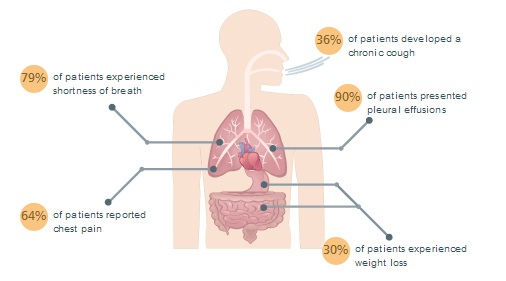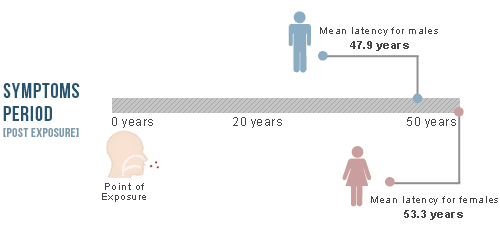
Mesothelioma Symptoms
A patient with mesothelioma usually begins showing mesothelioma symptoms 15 to 50 years after their exposure to asbestos. The cancer may take decades to develop in the body and symptoms do not arise until after the cancer is present. Common early mesothelioma symptoms include fatigue, coughing, shortness of breath and reduced respiratory function. Many patients are unaware they have developed mesothelioma. Mesothelioma symptoms typically resemble symptoms of less serious illnesses and occur so long after the initial exposure.
If you have a history of asbestos exposure, the leading cause of mesothelioma, and believe you may be showing signs of mesothelioma, it is best to seek immediate medical advice. Informing your doctor of previous asbestos exposure can alert them to the possibility of an asbestos-related disease such as mesothelioma.
Find a Treatment center in Your Area
What are the Pleural Mesothelioma Symptoms
Most pleural mesothelioma symptoms affect the respiratory system. Although they are rarely part of a patient's initial presentation and are typically discovered by imaging tests, pleural thickening or pleural plaques are also indicative of mesothelioma.
The most commonly reported pleural mesothelioma symptoms include:
- Chest pains
- Shortness of breath (dyspnea)
- Reduced chest expansion
- Barely audible or harsh breathing sounds
- Dry cough or wheezing
- Pleural effusions
These benign lesions can be as large as 6 cm in diameter and appear in scattered clusters across the visceral and parietal pleural surface. In a 2011 study of 221 pleural mesothelioma patients, mesothelioma symptoms were reported with the following frequency:

What are the Symptoms for Other Types of Mesothelioma
Peritoneal mesothelioma: Abdominal pain is one of the first peritoneal mesothelioma symptoms that most patients exhibit. This is commonly followed by abdominal enlargement and tenderness. Ascites, fluid buildups between the peritoneum and the abdominal organs, are very common, but they often develop later in the progression of the illness. In a study of 13 peritoneal mesothelioma patients, 77 percent of participants developed ascites.
Another peritoneal mesothelioma symptoms are the loss of appetite that often results in weight loss, abdominal distention/pelvic mass and abdominal hernias. In one study, 69 percent of peritoneal mesothelioma patients lost weight. Patients may also note bowel obstruction very late in the progression of peritoneal mesothelioma. Additionally, one Australian study found that 10 percent of all diffuse malignant peritoneal mesothelioma patients experienced short, mild seizures.

Pericardial mesothelioma: The few available case reports on pericardial mesothelioma name difficulty breathing and chest pain as the pericardial mesothelioma symptoms. These symptoms are the result of the pericardium thickening.
Testicular mesothelioma: The only consistent sign that has been presented by patients with testicular mesothelioma is a lump in the testes. Testicular mesothelioma is incredibly rare, yet as more studies are conducted, testicular mesothelioma additional symptoms may be revealed.
What Symptoms Indicate Metastatic Spread
Not all mesothelioma symptoms are confined to the site where the cancer originates. Mesothelioma symptoms that are most closely related to local invasion include:
 |
| Localized spread to the lymph nodes is most common and occurs in approximately 44% percent of cases. |
- Dysphagia (coughing/spitting up blood)
- Horner's syndrome (or other neurological syndromes)
- Laryngeal nerve palsy
- Nerve involvement of the arm
Paraplegia can occur if the cancer spreads to the spinal canal. Metastatic mesothelioma can also obstruct the superior vena cava. Hypoglycemia has also been reported as a clinical feature of invasive mesothelioma, yet this primarily occurs in patients with rare localized fibrous mesothelioma. Clubbing of the fingers and hypertrophic pulmonary osteoarthropathy (HPOA) are even rarer but occur in a handful of malignant mesothelioma cases, primarily when asbestosis is also present.
When do Mesothelioma Symptoms Emerge
Typically, patients notice the mesothelioma symptoms, 30 to 50 years after they were first exposed to asbestos. This latency period is not significantly different between varying subtypes of mesothelioma, but some studies have noted a shorter latency period for peritoneal mesothelioma (20 to 30 years) than pleural mesothelioma. However, in one 2011 study of 191 malignant mesothelioma cases, women were found to have a longer latency period than men:
 A larger retrospective study of 1,690 mesothelioma patients found the median latency period to be 32 years, while an even larger 2006 Italian study of 5,173 mesothelioma patients reported an average latency of 43.6 years. Once mesothelioma symotoms finally emerge, they are typically mild. Many patients may not pay attention to them when they first arise, only seeking a medical consultation when mesothelioma symptoms intensify. Additionally, a high percentage of mesothelioma patients have other respiratory diseases and the onset of mesothelioma is often misinterpreted as a progression of an existing condition such as COPD.
A larger retrospective study of 1,690 mesothelioma patients found the median latency period to be 32 years, while an even larger 2006 Italian study of 5,173 mesothelioma patients reported an average latency of 43.6 years. Once mesothelioma symotoms finally emerge, they are typically mild. Many patients may not pay attention to them when they first arise, only seeking a medical consultation when mesothelioma symptoms intensify. Additionally, a high percentage of mesothelioma patients have other respiratory diseases and the onset of mesothelioma is often misinterpreted as a progression of an existing condition such as COPD.

Because of the long latency period, mesothelioma symptoms are not always addressed right away. One study found that the interval between the first presentation of mesothelioma symptoms and referral to appropriate treatment was as high as 39 months.
View Article Sources
- http://www.annals.org/content/87/5/613.short
- http://www.ncbi.nlm.nih.gov/pmc/articles/PMC2652430/?tool=pubmed
- http://www.ncbi.nlm.nih.gov/pubmed/12908781
- http://www.ncbi.nlm.nih.gov/pmc/articles/PMC2999110/?tool=pubmed
- http://www.jstage.jst.go.jp/article/indhealth/49/2/49_166/_article
- Marinaccio, A., et al. (2006). Il Rapporto del Registro Nazionale dei Mesoteliomi. Roma Edizioni: Gruppo di Lavoro ReNaM.
No comments:
Post a Comment